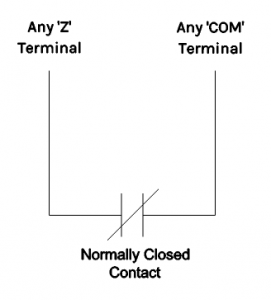How to Wire Security Alarm Zones
It is always good practice to use end of line resistors (EOLs) in any type of security circuit. There are, however, occasions when we may need to configure zones to operate without EOL supervision. On the flip side, there are cases where extra protection is desired. For this reason, most control panels allow for zones to be configured in one of three ways:
- Normally Closed Loops (no EOL – not recommended)
- Single End-of-Line Resistor
- Double End-of-Line Resistor
This article will explore each of three zone wiring types.
Note: this article does not discuss wiring for fire alarm circuits, which are wired Normally Open (NO).
Normally Closed Loops – No EOL
This is the simplest circuit and also the one with least protection from wiring faults. In this configuration, the circuit is not supervised for open or short circuit conditions. This is simply a normally open contact placed between Z and COM terminals.
- Zone normal or short circuit: 0Ω
- Zone violated or open circuit: ∞Ω
Single End-of-Line Resistor
This is the default circuit configuration. As the name implies, it uses only one EOL. The circuit is supervised against a short circuit, but there is no differentiation between a violated zone and an open circuit.
- Zone normal: 5600Ω (for DSC control panels)
- Zone violated or open circuit: ∞Ω
- Short circuit: 0Ω
Double End-of-Line Resistor
This is the most secure wiring type. With double End-of-Line resistor wiring, the control panel is able to differentiate between four conditions:
- Zone normal (contact closed): 5600Ω (for DSC control panels)
- Zone violated (contact open): 11,200Ω (for DSC control panels)
- Open circuit: ∞Ω
- Short circuit: 0Ω



